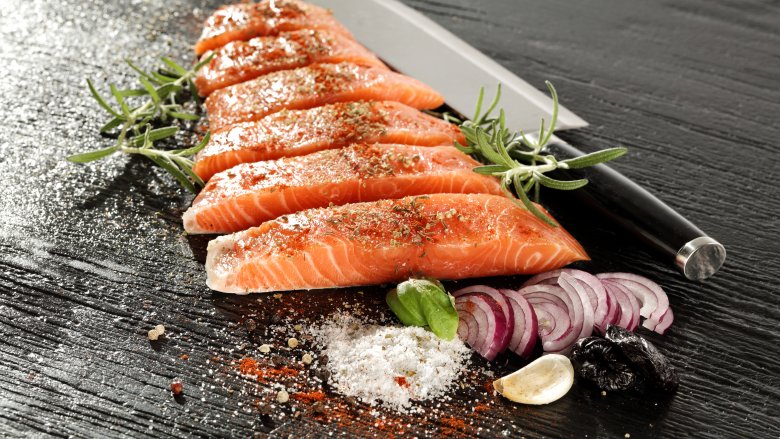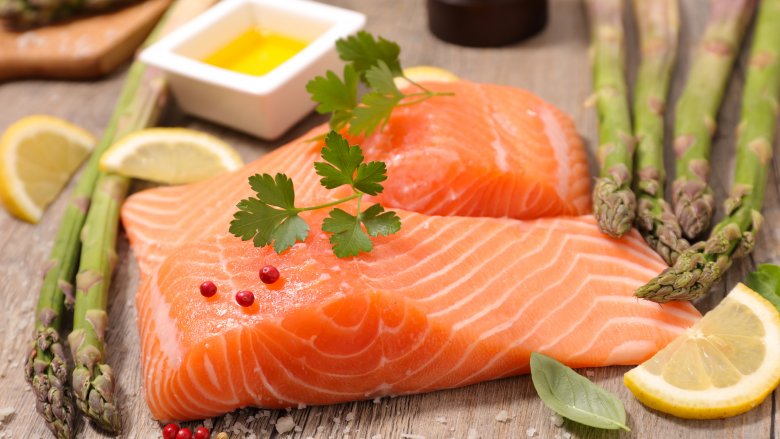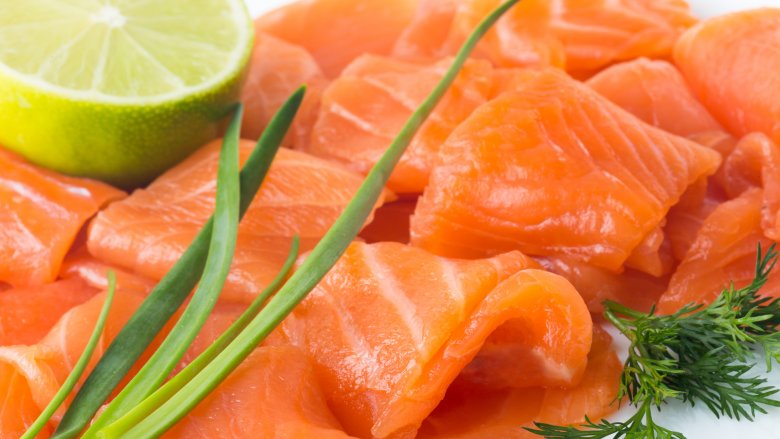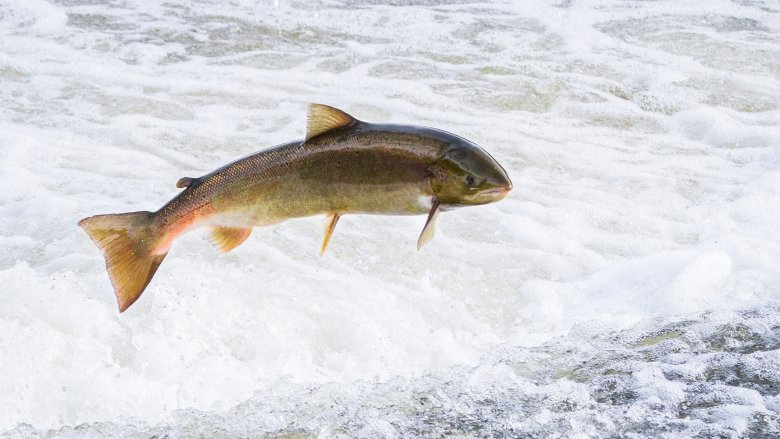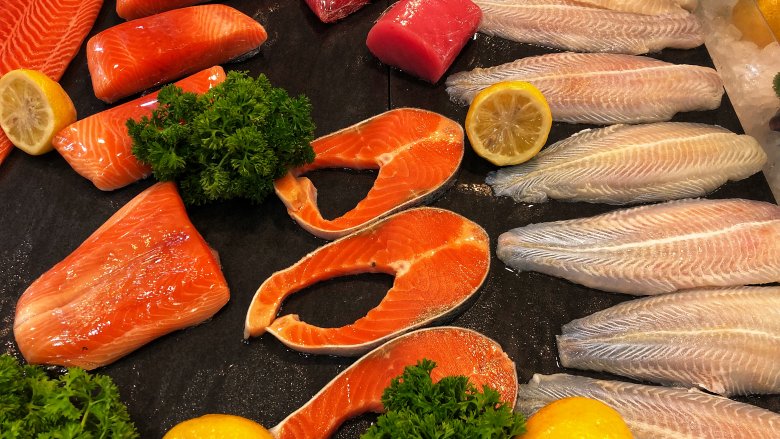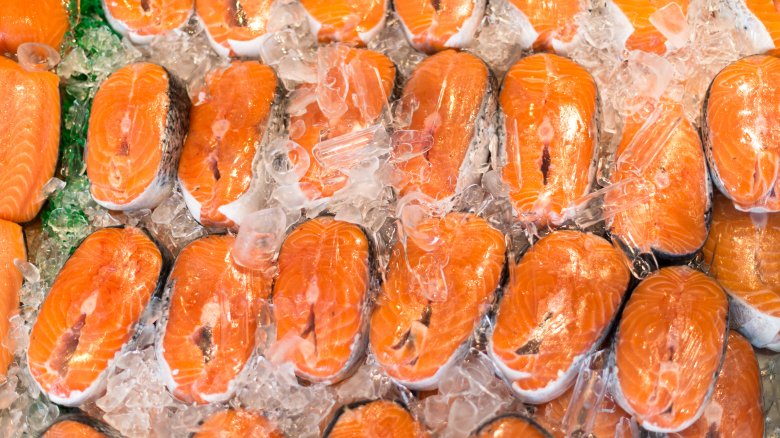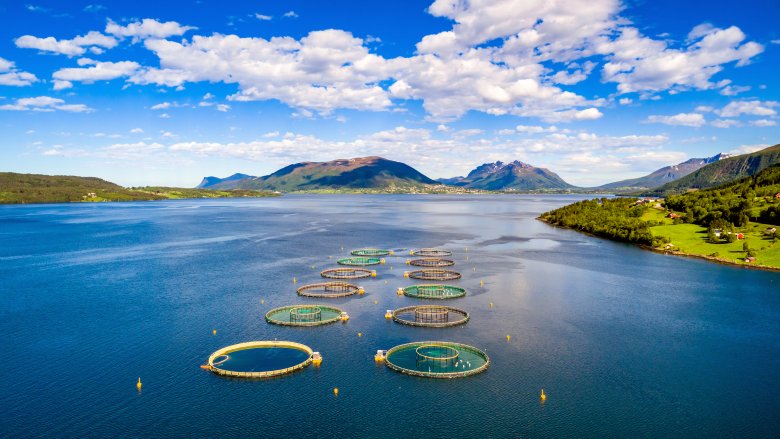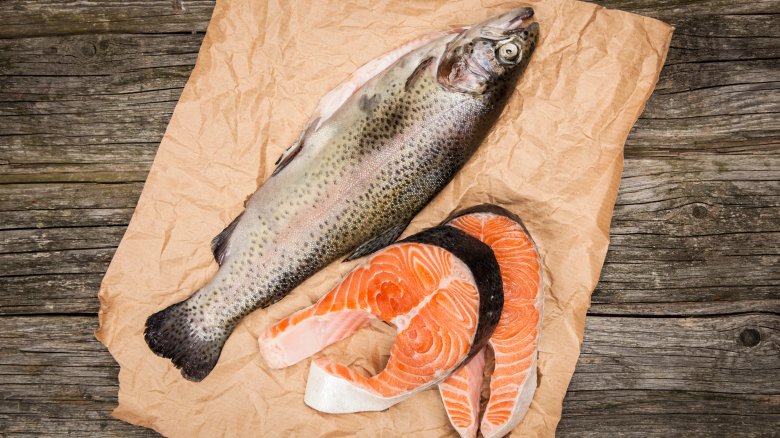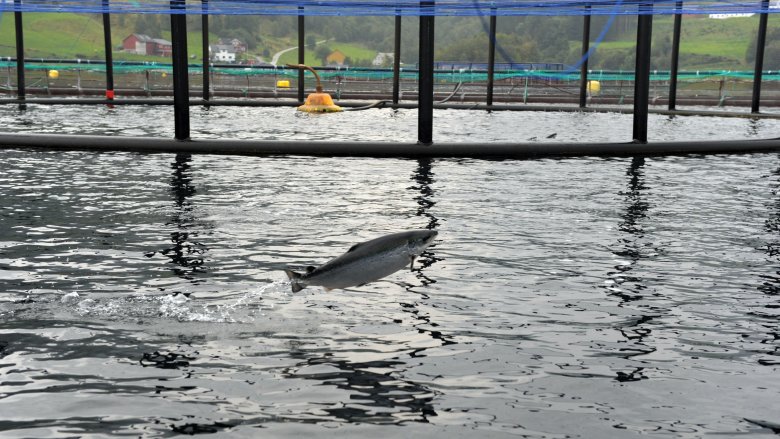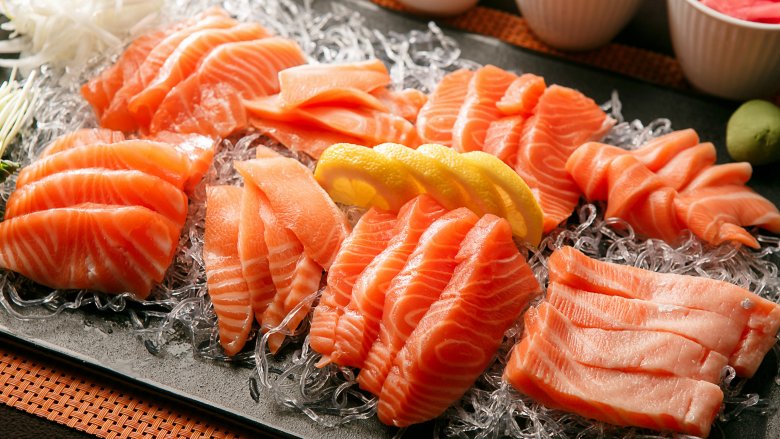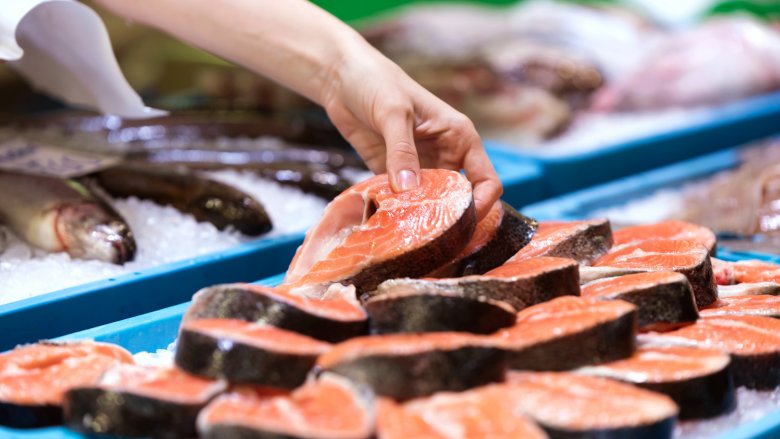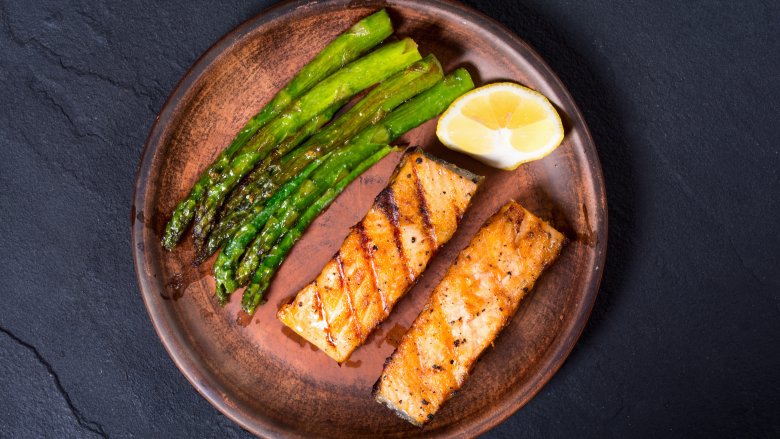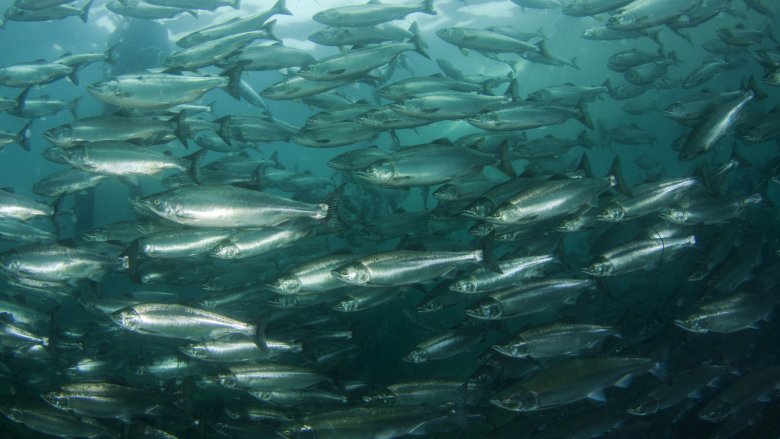The Truth About Farmed Salmon Vs. Wild Salmon
For families who regularly have fish on the dinner menu, there's a high likelihood salmon is a favorite. According to Sea Grant Delaware, the popularity of salmon is only surpassed by canned tuna and shrimp — and that means there's a lot of salmon being plucked out of the world's waters. But what waters are they coming from — and does it even matter? You bet it does.
First, a fun fact: "Salmon" actually refers to a group of different species defined by their unique lifestyle, which we'll talk about later. When it comes to the salmon that make it to the dinner table, there are mainly six different kinds eaten in the US. Coho, Chum, Chinook, Sockeye, and Pink typically come from wild fisheries in the Pacific, while Atlantic salmon is the type that usually comes from commercial fish farms.
Around two thirds of the US's salmon comes from farms, with the majority of those farms located in Chile, Norway, and Canada. (A relatively small amount is sourced from farms in Maine and Washington.) The other third is wild-caught, and that makes it very, very important to know exactly what the difference is when you're shopping for your family. There are a lot of differences between the two, so let's talk about what you need to know.
Are there nutritional differences?
Salmon is salmon, no matter where it comes from... right? Not exactly.
According to Heathline, there are some pretty staggering differences in the nutritional content of farm-raised and wild salmon. That's because they grow up eating entirely different things. While wild salmon eats mostly small invertebrates, farmed salmon is fed a diet of processed fish food that can vary by producer.
There's a lot of variation here depending on how much you're eating and how it's prepared, but here are some guidelines based on half of a fillet. While that half-fillet of wild salmon comes with only 281 calories, that jumps to around 412 calories when you're talking about the farm-raised stuff. How about fat? Wild salmon has around 13 grams of fat (and 1.9 grams of saturated fat), while the farm-raised kind comes with a whopping 27 grams (and 6 grams of saturated fat). That's a huge leap! Not everything is similarly impacted — they both contain about the same amounts of cholesterol and magnesium — but that just goes to show that not all salmon is created equal.
What's the story with fats and omega-3 fatty acids?
There's been a lot of talk about omega-3 fatty acids in recent years, and even if you're not sure why you need them, you probably know fish is one of the major sources. The National Institutes of Health says they've been linked to helping protect against cardiovascular disease, some types of cancer, Alzheimer's and dementia, and age-related eye conditions — so make sure you get your omega-3!
How much omega-3 you're getting in that serving of salmon is a tricky thing to figure out. According to Harvard Health, studies on the omega-3 content of the major varieties of farm-raised salmon can very between 717 mg and 1533 mg. That's a huge difference, but they also say that the farm-raised stuff generally has more than the wild.
Vital Choice says that the fat and omega-3 content of wild salmon depends on the type of fish, and the more omega-3 it has, the more fat it has, too. King (or Chinook) salmon has the highest of both, and that's because fish raised in colder environments tend to have more fatty tissue.
It's also worth mentioning that the good fats in farmed salmon vary, too. In 2016, the BBC reported on findings that omega-3 fatty acid levels in farmed salmon had dropped considerably when compared to the previous five years (thanks to a change in fish feeds), making it a perfect example of just how variable fish production can be.
Which one contains more organic pollutants?
The diets of both farmed and wild salmon impact exactly what ends up on your plate, and that can make things a little complicated — especially when it comes to pollutants.
Back in 2003, the Environmental Working Group published their findings that farm-raised salmon were higher in environmental and organic pollutants, mostly because they were intentionally fattened with fish meal and fish oil made from small, open-sea fish. It's food chain basics: they ate contaminated fish, and then built up higher levels of contamination themselves, since they were being fed and fattened more than wild salmon. But that was then.
But more recent studies from the Havforsknings Instituttet of Norway — one of the largest salmon-producing countries — suggest things have changed, and if you're staying away from farm-raised salmon because you've heard that first part of the research, you don't need to worry now. Most farms are skipping the fish oil, which was one of the feed components that was causing the most contamination. Now, there are similar levels of pollutants found in both types (though the farmed salmon levels were actually a bit lower). If that sounds scary, you should also know that experts stress that pollutant levels for both types were "relatively low" and say it's not a reason to skip either type.
The shocking difference in color — and which is which?
Telling the difference between species of fish is tough, which is why it's not surprising Oceana says seafood fraud is so widespread. Salmon is easy though, right? It's a distinctive pinkish-red, after all... only, not all of it comes that way without a little help.
Wild salmon get their deep orange-red color naturally, and it comes from a compound called carotenoids. It's in the krill, shrimp, and other invertebrates that wild salmon eat. Farmed salmon, though, don't have the same access to all the little critters that change their color.
And that means farmers need to supplement the diet of their farm-raised salmon with additives that are going to turn their naturally white or gray flesh a more widely accepted pink. It's still generally a lighter color flesh than the wild salmon, but it's close enough for most consumers. According to Time, most farmers supplement with carotenoids taken from green algae, ground up from crustaceans, or created in a lab, and added to their food — and it's not a cheap process. Additives to make their salmon pink account for about 20 percent of the cost of feeding the fish, but it's also necessary, they say. Market surveys found that color is a huge factor for consumers, and the darker the hue, the more they were willing to pay for the fish.
Should you worry about mercury in either?
Every so often, warnings about the mercury content in fish hit the headlines. According to the EPA and FDA, mercury warnings are of the most concern for women between 16 and 49, women who are pregnant or breastfeeding, and young children. Fortunately, salmon is on their list of "best choices" when it comes to fish.
In 2004, Oxford Academic's BioScience took an in-depth look at pollutants — including mercury — in salmon. According to them, the average Coho was around .0000027 percent mercury, and for some comparison, there was also about 27 percent protein in that same fish. They added that salmon has among the lowest levels of mercury across the board, and their work analyzing the compounds found in Alaska fish showed they were way, way below levels that would cause the least bit of alarm.
And that's remained pretty consistent. According to The Guardian, both wild and farmed salmon remained low in mercury content into 2017 — great news for salmon lovers.
Is antibiotic use a big deal?
Antibiotic use in the meat industry is complicated (and we take an in-depth look at it here). Essentially, the worry is this: when antibiotics are used to increase the weight of animals instead of only to fight illness, that raises the amount of antibiotics that make it into our food chain and ultimately make them less effective when we need them. With salmon, it's complicated.
It's only with farmed salmon that antibiotic use is an issue, and according to the World Health Organization, Norway has cut their use of antibiotics in salmon farming to almost nothing. They've even switched to vaccinating their fish against diseases they were previously using antibiotics to treat, and they've also made strides in improving the cleanliness of the conditions fish are kept in. That's all good news, but it's less good when you look at one of the world's other mass producers of salmon.
According to Oceana, Chile's salmon farmers are one of the biggest users of antibiotics in the livestock industry. Coupled with the closely-packed conditions they're raised in, Chilean salmon is raised in precisely the sort of environment scientists are worried about. Liesbeth van der Meer of Oceana Chile sums it up this way: "Consumers should be worried that we are creating a super-bacteria here in Chile."
So if you're concerned about antibiotic in your salmon, find out where it came from — it matters.
Would you like worms or lice with that?
First, let's talk about wild salmon. In July 2018, The Mercury News reported on one woman's stomach-turning discovery: the salmon she had just bought from Costco had worms wiggling about beneath the plastic. LiveScience added there are a couple of different worms that can be found in fish, and that they can infect people and may require surgery to remove. Freezing (for at least seven days) is typically the best way to make sure the worms aren't wriggling anymore, but bad news: Munchies says that pretty much every kind of wild-caught fish you can imagine has these little worms. Will cooking get rid of them? Not so much — fish rarely reaches the temperature you need to kill the little pests.
Farmed fish are usually treated for these types of parasites, but they have another problem: sea lice. According to the UK's Natural History Museum, sea lice are tiny little creatures that have been around for millions of years, and can only survive by attaching themselves to a fish and feeding on the creature's blood and skin. While they do exist in the ocean, the closely-packed waters of salmon farms make it much easier for the tiny larvae to find a host, reproduce, and thrive. Chemicals have been the only way to get rid of widespread infections, and so many have been used that sea lice have built up a resistance to many of them.
So farmed or wild? That depends on what kind of parasite creeps you out less.
How ethical is farming salmon?
While most fish are either freshwater or saltwater, salmon have a pretty unique life cycle. The National Park Service says eggs are laid in and hatch in freshwater streams, and depending on the type, they can spend up to a year in their little natural nurseries. Eventually, they'll all head toward the nearest ocean, where they'll spend between one and seven years growing to adulthood and maturing. Then, they react to some sort of cue (that's not yet understood by us), and they'll make the return trip to where they were hatched. Eggs are laid, fertilized, and the adult fish die.
Some wild salmon can travel hundreds and hundreds of miles, and it's that wandering lifestyle that's led animal welfare groups and environmentalists to condemn farm-raising salmon as nothing short of cruel (via the Independent). Some retailers — like the UK's Marks & Spencer — have partnered with the RSPCA and their Freedom Food program to help make sure salmon are raised in more responsible, kinder ways, but it's still food for thought.
Which tastes better?
Wild salmon has a lot of marks in its favor, and it's more expensive, so it must be better... right? When it comes to taste tests, though, an experiment done by The Washington Post suggests the results of which actually tastes better might surprise you.
They assembled an all-star panel of judges (including seafood chefs and wholesalers), and had Scott Drewno, executive chef at Wolfgang Puck's The Source, do the cooking. There was wild and farmed salmon, fresh and frozen, and the winner? Costco's farmed and frozen Atlantic salmon.
Shocking, right? They note that the winner was packed in salt, a preparation method that makes it firmer — and texture is always important. But the next highest-rated fish were also farmed. Some of the judges had different opinions, sure, but out of the 10 samples they rated, the highest-rated wild salmon came in at number 6.
Field & Stream condemned the results (saying, "Yeah, whatever."), but if it's taste you're concerned about... there's your answer.
What do all these labels actually mean?
Head to the grocery store or the fishmonger, and you'll find it's not as straightforward as just picking up something that's farm-raised or wild caught. The USDA has a whole series of rules and regulations when it comes to labeling seafood (via Cooking Light), and that means there are some weird terms you might see pop up on salmon labels.
First, if it says "Atlantic salmon", you should know that's almost a guarantee it was farm-raised. Pacific salmon, on the other hand, are often wild but can come from a farm. (Also, "Wild Alaskan Salmon isn't a type of salmon, it's just salmon that was caught in Alaska).
If it's labeled "sustainably farmed," that means they were raised in tanks, not in cages or oceans in the open waters. This method means there's less chance of contamination or parasite infection, and the fish probably had more room to swim and lived in a cleaner environment.
There's one term in particular you should keep an eye out for if you're looking for wild salmon, and that's troll-caught. That's a reference to a hook-and-line method of fishing that's super sustainable, so if that's important to you — and you're fine with the hefty price tag that comes with it — it's worth it.
It's also worth noting that since there are no official USDA guidelines when it comes to labeling fish organic, you can safely ignore this one.
How do you know you're not a victim of fish fraud?
Once it's on the plate or in the package, it's tough to tell just what kind of fish you're getting. It's not like telling the difference between beef and chicken, after all, so how do you know you're really getting the kind of salmon you want?
According to Anders Miller, the owner of Seattle's Pike Place Fish Company (via Cooking Light), there are a few ways you can tell if you're getting wild-caught or farm-raised salmon.
First, look at the color and the pattern of the fat. Wild salmon tends to be reddish-orange, while farmed salmon is pink. Farmed fish also has a lot more of that fatty marbling through it, because they're not swimming against currents like wild salmon has to. If the fish you're looking at still has a tail, that's another giveaway. Wild salmon have big, fan-shaped tails, while the tail fins of farmed salmon tend to be smaller and often look ragged from being nipped by other fish.
There's also a specific season for wild salmon, and if you're not getting it from between the middle of May to September, it's probably farmed. If it doesn't specifically say "wild," there's also a high likelihood it's farmed. Keep an eye on the price point, too: wild salmon is typically much more expensive.
Is salmon farming threatening populations of wild salmon?
While it might seem more environmentally conscious to opt for farm-raised salmon than wild, it's not actually that easy.
In 2018, scientists were reporting (via CTV News) on a big problem. Farm-raised Atlantic salmon housed in pens off the coast of British Columbia were infected with a serious and highly contagious disease that caused jaundice, heart and skeletal inflammation, and ultimately, organ failure. What made the problem even bigger was the potential for this disease — and others — to be spread to the native, wild Pacific salmon.
Watershed Watch says this isn't the only problem, and it's not the only time diseases carried and bred in the close quarters of a salmon farm's nets has spread to wild species. Salmon farms are also breeding grounds for sea lice, and since wild salmon often pass through the farms during their migrations, they can easily spread. Since as few as three sea lice can kill a juvenile salmon, the consequences can be devastating.
There's also the possibility of large- and small-scale escapes, where farm-raised fish break free of their nets and can quickly ravage the entire ecosystem. And it does happen — around 300,000 farm-raised salmon escaped from a Washington farm in 2017.
